33. habitus (female): dorsal view (photo)
Tip: no legs
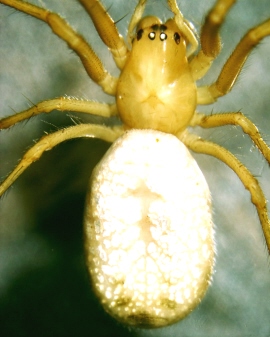
Manual for Standard Views
Please send corrections & nicer example images to [email protected]ID#. required
ID#. conditionally required
Preparation 1. Female in alcohol
|
33. habitus (female): dorsal view (photo)
Tip: no legs |

|
|
37. habitus (female): ventral view (photo)
Tip: no legs |
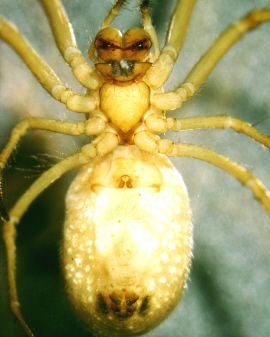
|
|
377. habitus with legs (female): lateral view (photo)
Tip: with legs |
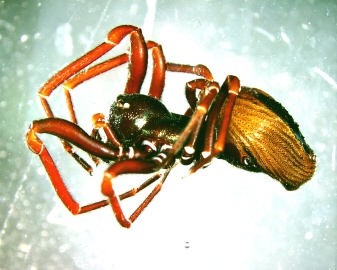
|
|
35. habitus (female): lateral view (photo)
Tip: no legs |
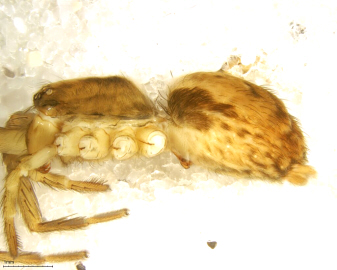
|
|
365. cephalothorax and base of appendages (female): ventral view (photo)
Tip: including coxae, trochanters, chelicera and pedicel |
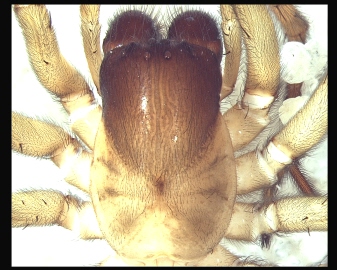
|
|
104. leg I (female): prolateral view (photo)
Tip: this can be imaged before mounting for SEM |
|
370. trochanter > leg I (female): ventral view (photo)
Tip: make sure the notch area is visible |
|
372. leg IV (female): retrolateral view (photo)
Tip: this can be imaged before mounting for SEM |
|
369. trochanter > leg IV (female): ventral view (photo)
Tip: make sure the notch area is visible |
Preparation 2. Carapace, endites, labium (female)
|
43. labrum (female): anterior-proper view (SEM)
Tip: elevated labra often require an oblique lateral view |
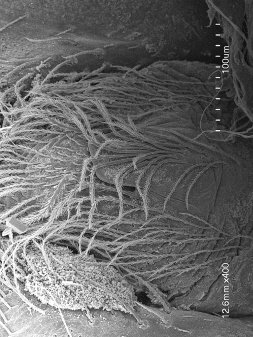
|
|
44. labium (female): ventral-posterior view (SEM)
Conditionally required: include if not adequately illustrated in SV 78 |
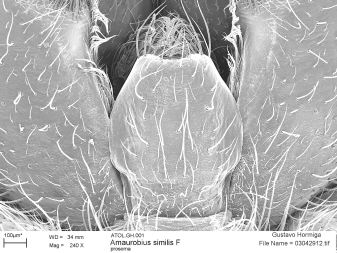
|
|
47. sternum (female): ventral view (SEM)
Tip: include pedicel
Zoom and check: if complex sclerites, then add SV 237 |
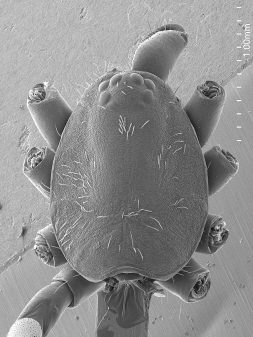
|
|
53. carapace (female): proper view, detail texture (SEM)
Conditionally required: include if not adequately illustrated in SV 67 |
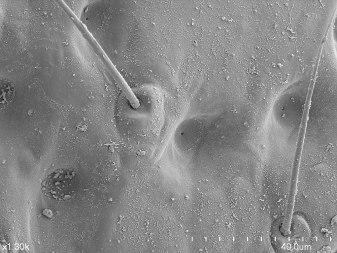
|
|
359. hairs carapace (female): proper view, closeup one seta (SEM)
Conditionally required: include if not adequately illustrated in SV 67 |
|
358. scales carapace (female): proper view, closeup one seta (SEM)
Conditionally required: include if not adequately illustrated in SV 67 |
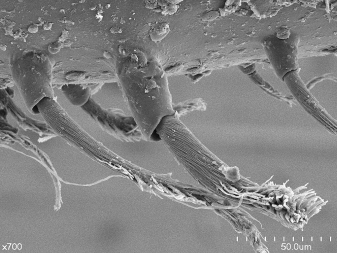
May use standard legs and segments to illustrate setae, but include extra images if something different occurs elsewhere. |
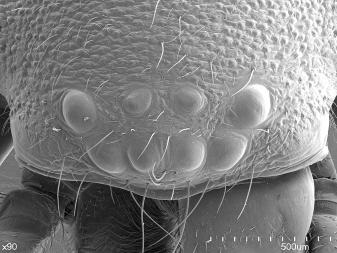
|
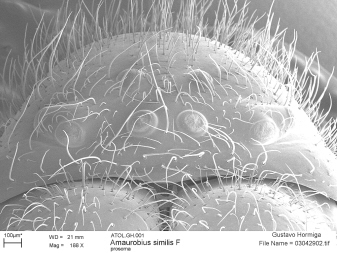
|
|
65. eyes (female): lateral view (SEM)
Tip: include all clypeus
Additional structures you may found there: if suprapalpal (?) glands present, add SV 6 |
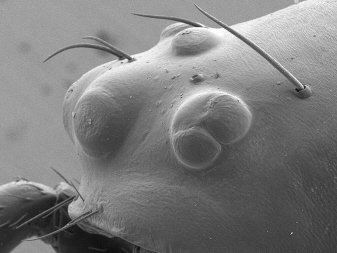
|
|
6. lateral pore pit (suprapalpal) > cephalic area (female): proper view (SEM)
When present! |
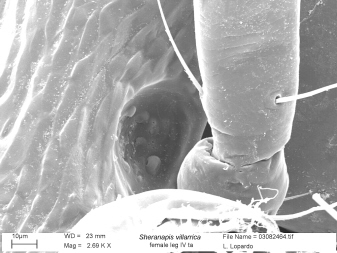
|
|
67. fovea > carapace (female): dorsal-proper view (SEM)
Tip: Fovea area, even if fovea not present
Zoom and check: ultrastructure of carapace cuticle (fingerprint, etc.), hairs, and scales; if not adequately resolved in this view, add SV 53, SV 358, SV 359 |
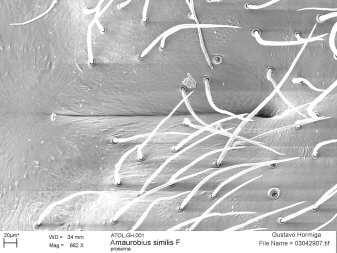
|
|
77. coxa-endite > palp (female): dorsal-anterior view (SEM)
Zoom and check: full extention of serrula, if teeth not well resolved add SV 79 |
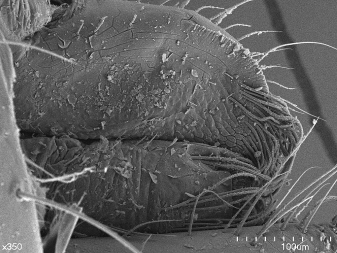
The endites could go in the carapace preparation� 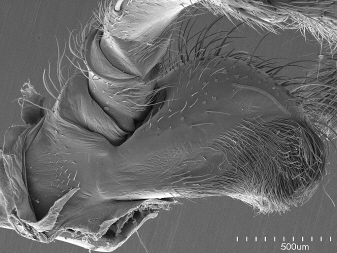
�or dissected with the palp |
|
78. coxa-endite > palp (female): ventral-posterior view (SEM)
Tip: both left and right, including labium
Zoom and check: labium adequately resolved; if not, add SV 44 |
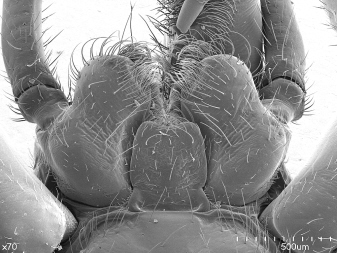
|
|
79. serrula > coxa-endite > palp (female): dorsal-lateral view (SEM)
Conditionally required: include if not adequately illustrated in SV 77
Zoom and check: serrula teeth well resolved |
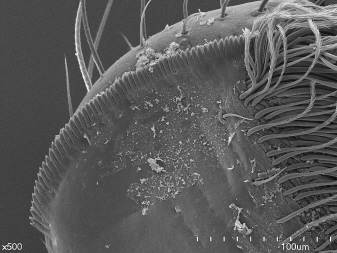
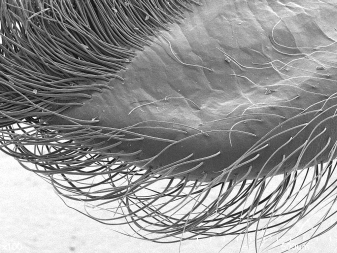
Document absence of serrula. |
|
234. pedicel (1st abdominal segment) (female): dorsal view (SEM)
Comments: Charles has asked for an oblique view; consider some examples and decide |
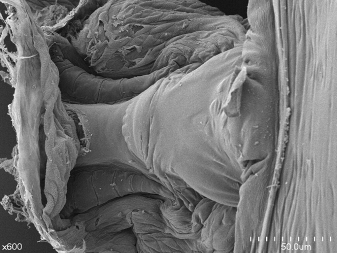
|
|
237. pedicel (1st abdominal segment) (female): ventral view (SEM)
Conditionally required: default view taken together with sternum in SV 47; add this view if complex |
Preparation 3. Chelicera (female)
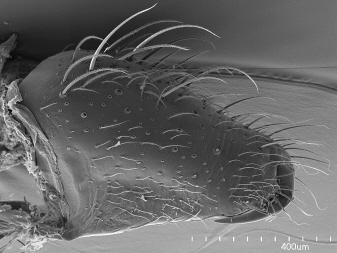
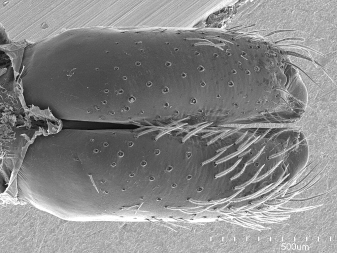
When chelicerae are fused they could be mounted together |
|
70. chelicera (female): posterior view (SEM)
Tip: If the venom gland comes out with the chelicera, mount and then take a whole image of chelicera plus venom gland |
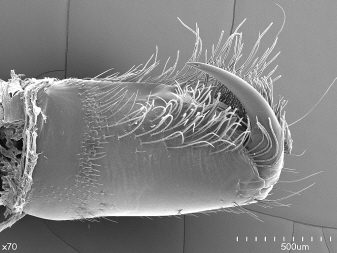
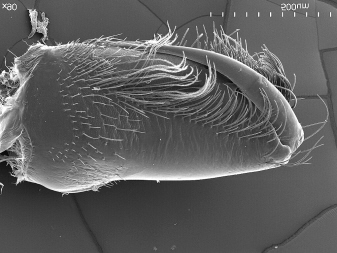
Try to avoid closed fangs |
|
69. chelicera (female): ectal view (SEM)
Additional structures you may found there: stridulatory file, add SV 8 if necessary; cheliceral boss striae, if present add SV 7 |
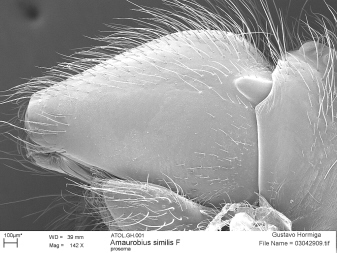
|
|
7. cheliceral boss > paturon (female): lateral-anterior view (SEM)
When present! |
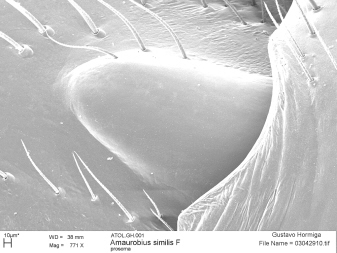
|
|
8. stridulatory files > paturon > chelicera > appendages cephalothorax (female): lateral-proper view (SEM)
When present! |
|
71. promargin > paturon (female): anterior-ventral view (SEM)
Comments: views differ in non-Araneomorphae |
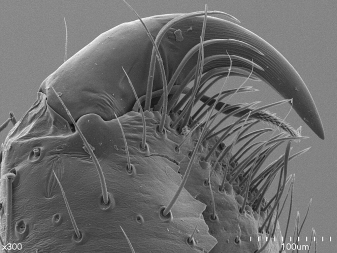
Get all relevant setae in frame and in focus. 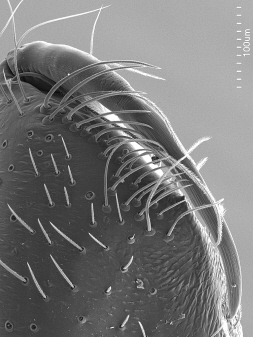
Include complete fang in frame. |
|
73. cheliceral gland (female): proper view (SEM)
Conditionally required: include if not adequately illustrated in SV 72 |
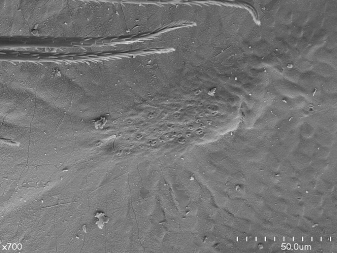
The cheliceral gland often needs a much higher contrast than the rest of the shots. |
Preparation 4. Palp (female)
|
361. palp (female): prolateral view (SEM)
Tip: SEM of entire mount |
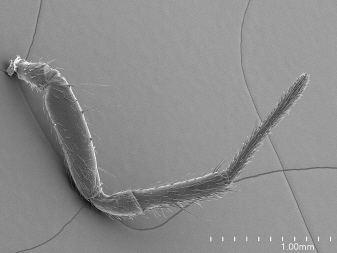
|
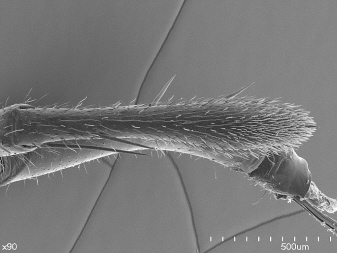
|
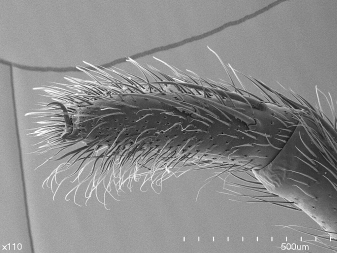
|
|
101. tarsus > palp (female): apical view (SEM)
Tip: retrolateral side shaved
Zoom and check: document absence of claw |
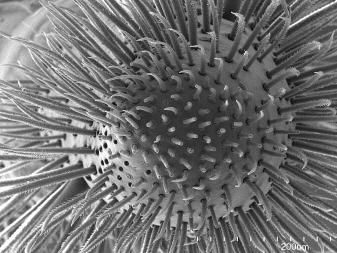
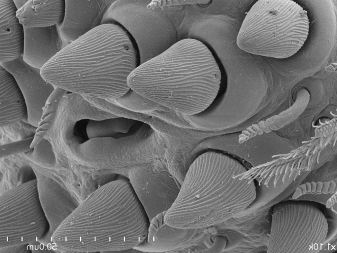
Document absence or reduction of claws. |
Preparation 5. Leg I, female
|
360. leg I (female): prolateral view (SEM)
Tip: general SEM of the entire preparation |
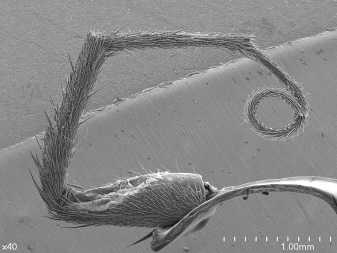
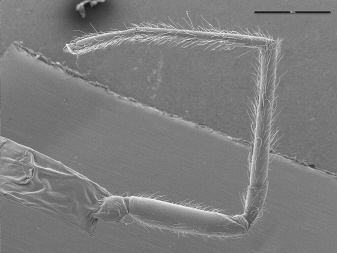
|
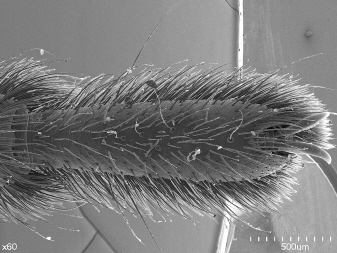
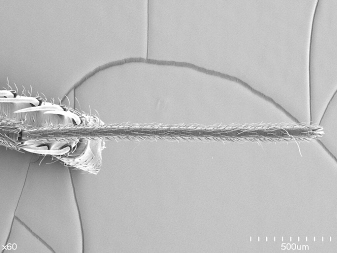
Include entire tarsus |
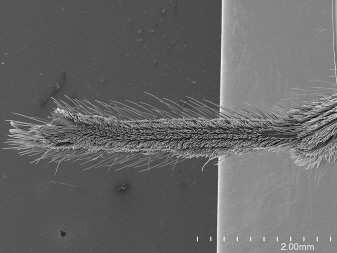
|
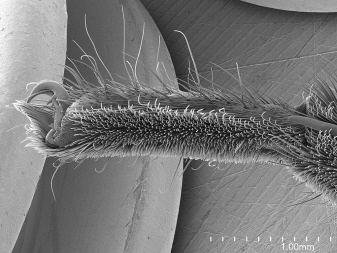
|
|
130. claws > leg I (female): apical view (SEM)
Tip: retrolateral side shaved, two images show teeth of all claws (or complete with extra images) |
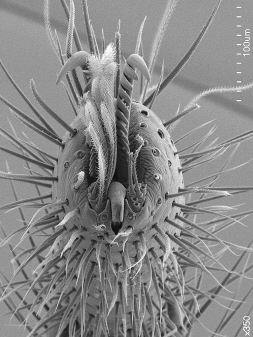
|
|
217. hairs appendages (female): proper view, closeup one seta (SEM)
Tip: generic; by default use tibia I lateral |
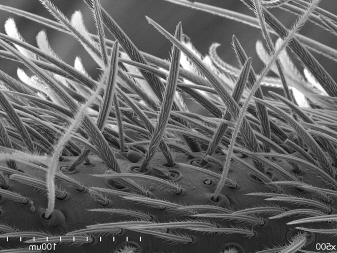
Look for diversity in setae. |
|
219. scales appendages (female): proper view, closeup one seta (SEM)
When present! |
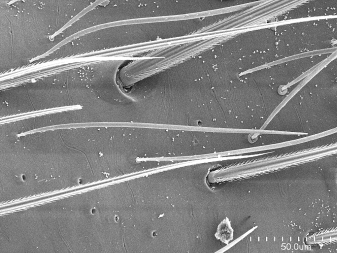
|
|
221. scopular setae (female): retrolateral-proper view, closeup one seta (SEM)
When present! |
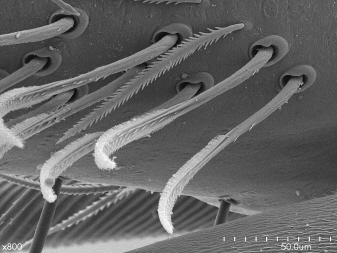
Get well exposed base and tenent surface in focus. This image might be used as SV 219 as well, because the a scale is well figured along with the scopular seta. |
|
222. scopular setae tenent surface (female): proper view, closeup (SEM)
When present! |
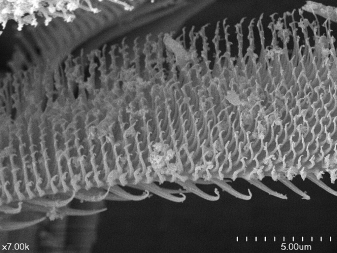
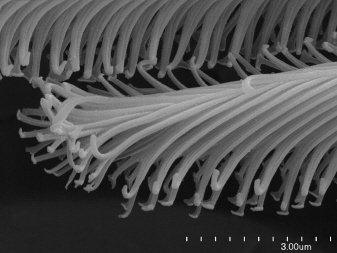
|
|
15. claw tuft setae (female): retrolateral-proper view, closeup (SEM)
When present! |
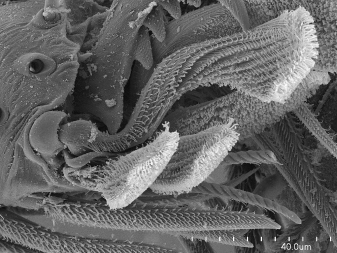
|
|
16. claw tuft setae base (female): retrolateral-proper view, closeup (SEM)
When present! |
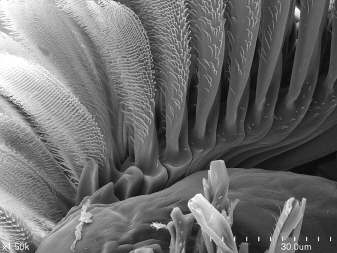
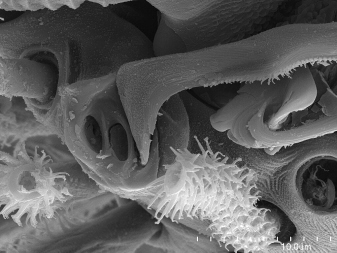
|
|
17. claw tuft setae tenent surface (female): proper view, closeup (SEM)
When present! |
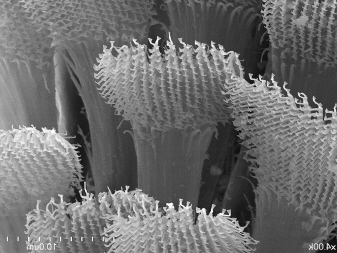
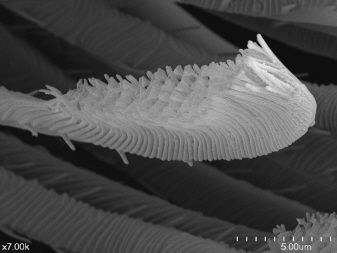
|
|
223. chemosensory setae (female): proper view, closeup (SEM)
Tip: by default use cymbial tip or cymbial dorsal pad; check with some examples that e.g., tibial and cymbial setae look similar |
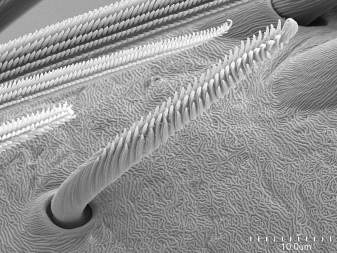
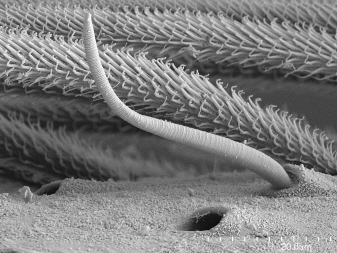
|
|
353. trichobothrial socket: proper view (SEM)
Tip: by default use female tibia I dorsal; make sure that the setal base is illustrated |
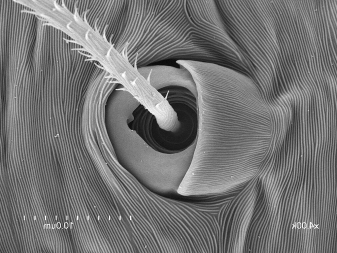
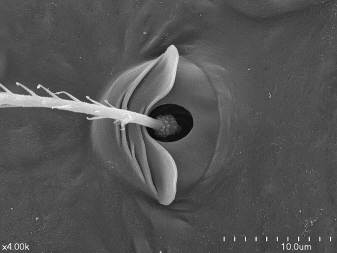
|
|
354. tarsal organ (female): dorsal-proper view (SEM)
Tip: generic; by default use tarsus I |
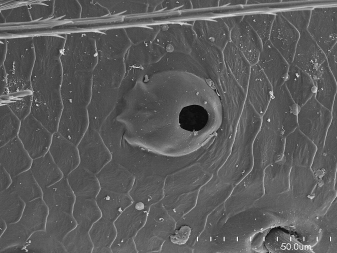

|
|
380. leg cuticle texture: proper view (SEM)
Conditionally required: include if not adequately illustrated in e.g., SV 353, SV 354
Zoom and check: Sometimes the cuticle texture varies in different parts of the leg (e.g., smooth on tarsus, but imbricate on tibia) |

The cuticle texture is often well illustrated together with trichobothria or tarsal organ 
The cuticle texture is often well illustrated together with trichobothria or tarsal organ |
Preparation 6. Leg IV, female
|
362. leg IV (female): retrolateral view (SEM)
Tip: general SEM of the entire preparation |
|
206. metatarsus > leg IV (female): dorsal view (SEM)
Zoom and check: metatarsal dorsal stopper may have oddities (Sparassidae) |
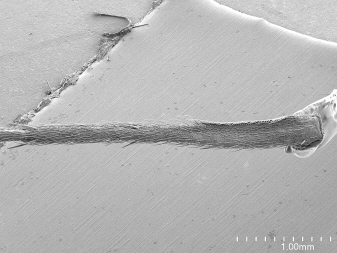
|
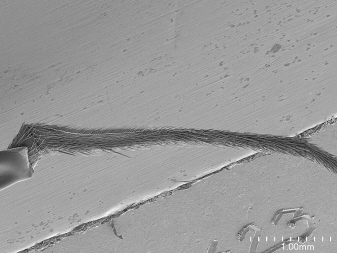
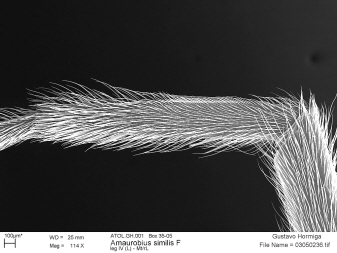
|
|
367. preening comb in metatarsus > leg IV (female): ventral view (SEM)
When present! |
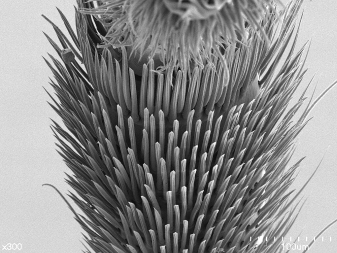
|
|
10. calamistrum (female): retrolateral-dorsal view, entire calamistrum (SEM)
When present! |
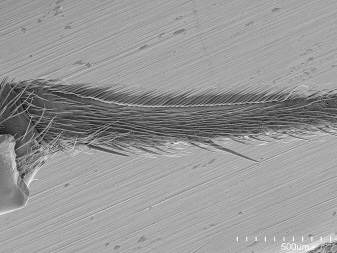
|
|
11. calamistrum (female): retrolateral-dorsal view, calamistrum sector several setae (SEM)
When present! |
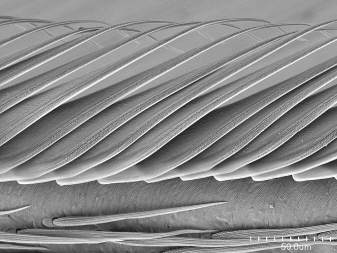
Check that tips and bases are in frame. |
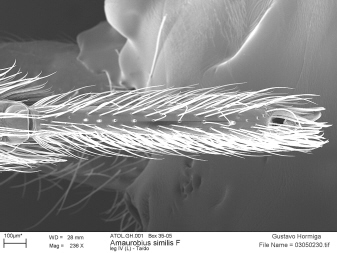
|
|
213. tarsus > leg IV (female): ventral view (SEM)
Tip: include metatarsal tip
Zoom and check: preening comb resolved or add SV 367; tarsal comb resolved or add extra image (may need an additional, non-standard angle); sustentaculum resolved or add in SV 355, or directly as SV 13 |
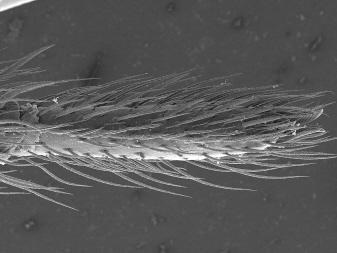
Similar to this, but should include more of metatarsus tip. |
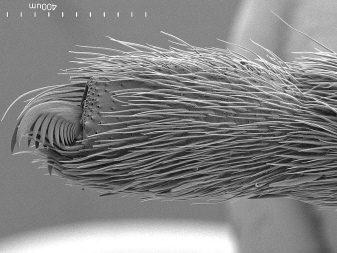
|
|
13. sustentaculum > tarsus > leg IV (female): proper view (SEM)
When present! |

|
|
14. tarsal combs > tarsus > leg IV (female): proper view, detail seta (SEM)
When present! |
|
355. claws > leg IV (female): ventral view (SEM)
Tip: include modified setae close to claws
Zoom and check: accessory claws; if sustentaculum present and not resolved add SV 13 |
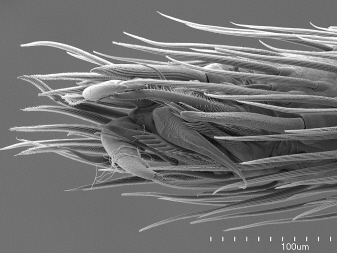
|
|
216. claws > leg IV (female): retrolateral-apical view (SEM)
Tip: retrolateral side shaved, two images show teeth of all claws (or complete with extra images)
Zoom and check: accessory claws |
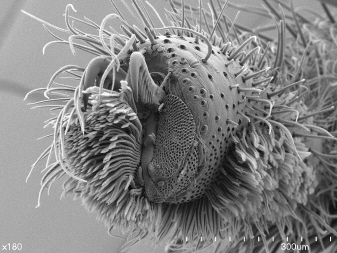
|
|
214. claws > leg IV (female): apical view (SEM)
Tip: retrolateral side shaved, two images show teeth of all claws (or complete with extra images) |
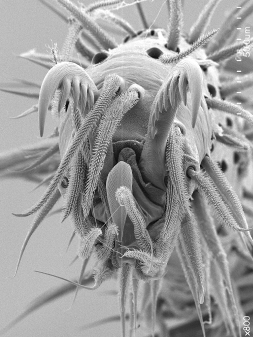
|
Preparation 7. Epigyne and vulva trypsine digested
|
292. epigynum (female): ventral view (photo)
When present! |
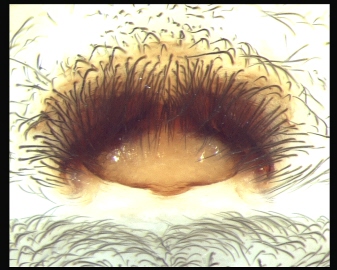
|
|
293. epigynum (female): ventral view (SEM)
When present! |
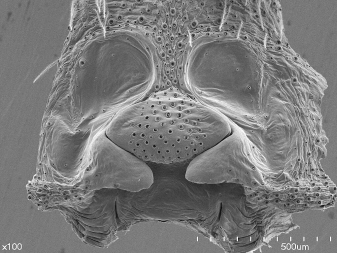
|
|
290. epigynum (female): posterior view (SEM)
When present! |
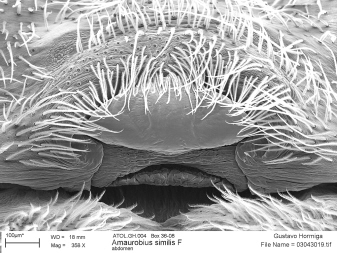
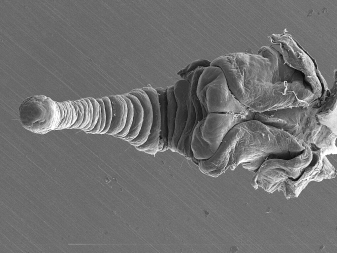
|
|
19. dictynoid pore > vulva (female): proper view (SEM)
When present! |
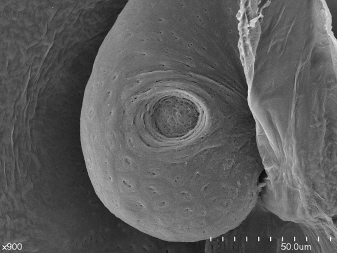
|
|
298. secondary spermatheca (SP2 or head) (female): proper view (SEM)
When present!
Zoom and check: including pores |
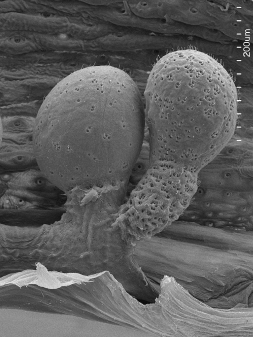
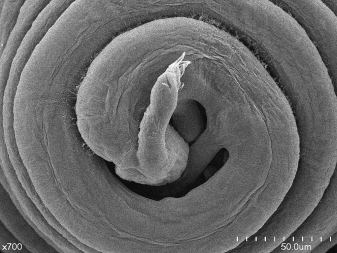
|
|
20. epigynal glands > vulva (female): dorsal-proper view (SEM)
When present! |
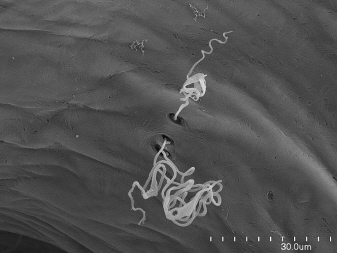
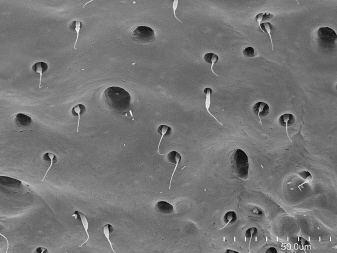
|
Preparation 8. Spinnerets female
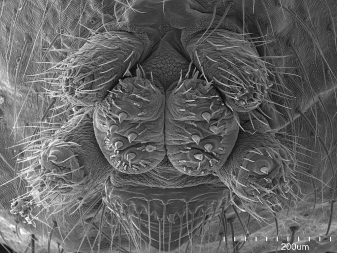
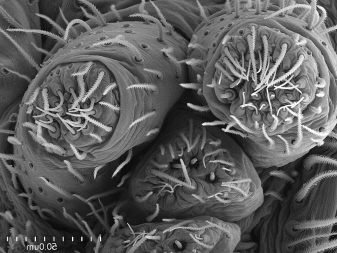
One half is OK, but it is somewhat difficult to interpret spacing and general conformation. |
|
248. spinnerets (female): lateral view (SEM)
Tip: this is to illustrate the relative lengths of the spinnerets, especially the PLS |
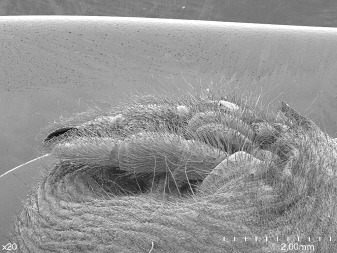
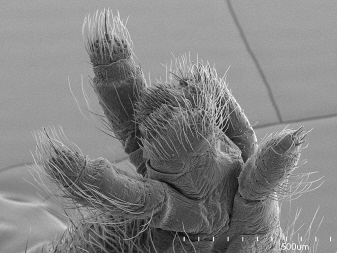
|
|
251. AMS-cribellum-colulus (female): ventral view (SEM)
When present! |
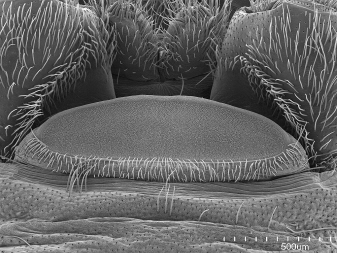
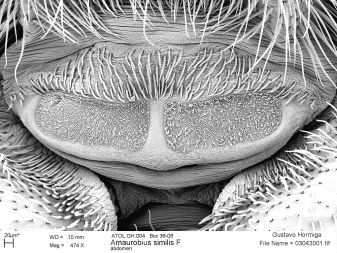
|
|
253. cribellar spigots (female): ventral-proper view (SEM)
When present!
Zoom and check: ultrastructural details of spigots |
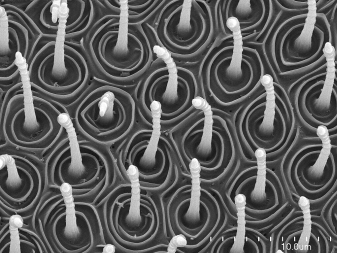

|
|
254. ALS spinning field (female): ventral-proper view (SEM)
When present!
Zoom and check: fine texture of spigots (shaft and base), tartipores, and spinning field cuticle, add extra images if necessary (SV 256, SV 258, SV 260) |
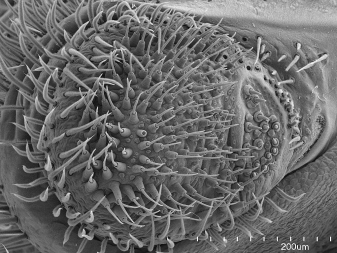
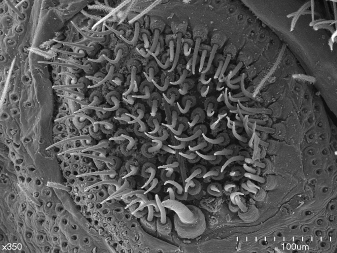
Shave distal article when necessary. |
|
256. maAmp > ALS spinning field (female): ventral-proper view (SEM)
Conditionally required: usually illustrated in SV 254 |
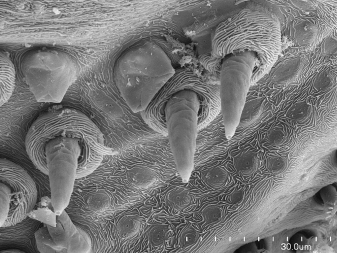
|
|
258. maAmp field > ALS spinning field (female): ventral-proper view (SEM)
Conditionally required: usually illustrated in SV 254 |
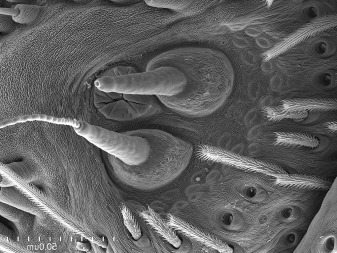
Get sensilla in focus. 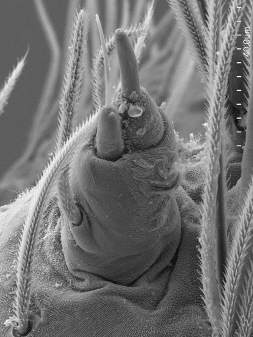
|
|
260. Pi > ALS spinning field (female): ventral-proper view (SEM)
Conditionally required: usually illustrated in SV 254 |
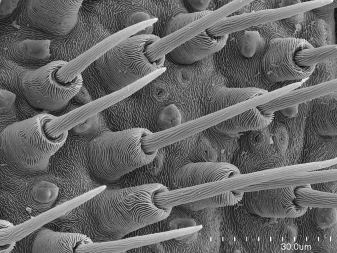
|
|
266. PMS spinning field (female): ventral-proper view (SEM)
Tip: entire spinning field or add extra images
Zoom and check: fine texture of spigots (shaft and base), tartipores, and spinning field cuticle, add extra images if necessary (SV 268, SV 270, SV 272, SV 273) |
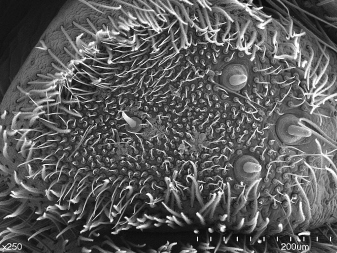
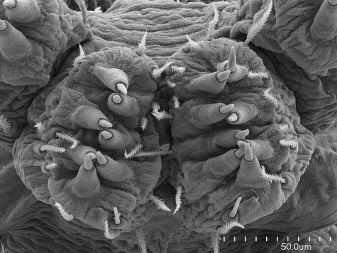
|
|
268. miAmp > PMS spinning field (female): ventral-proper view (SEM)
When present! |
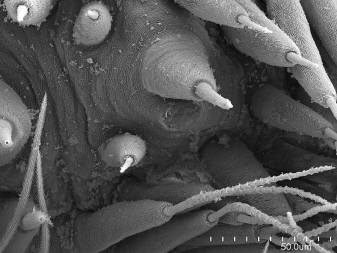
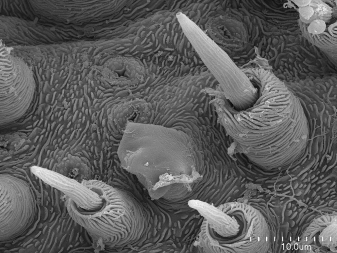
The same image will suffice to document both miAmp and Ac. |
|
270. Ac > PMS spinning field (female): ventral-proper view (SEM)
When present! |

The same image will suffice to document both miAmp and Ac. |
|
272. Cy > PMS spinning field (female): ventral-proper view (SEM)
When present! |
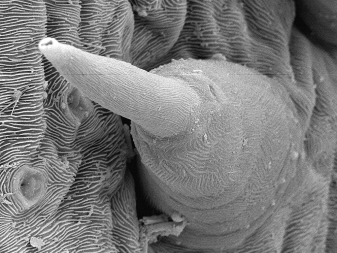
|
|
273. PC > PMS spinning field (female): ventral-proper view (SEM)
When present! |
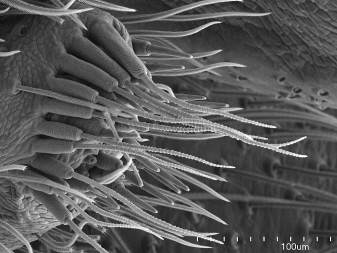
|
|
276. PLS spinning field (female): ventral-proper view (SEM)
Tip: entire spinning field or add extra images
Zoom and check: fine texture of spigots (shaft and base), tartipores, and spinning field cuticle, add extra images if necessary (SV 278, SV 280, SV 281, SV 283) |
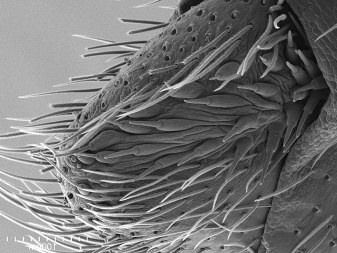
Shave when necessary 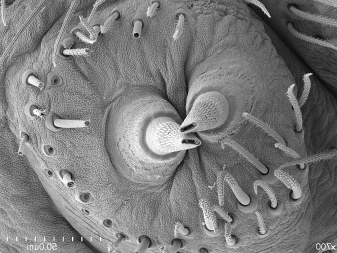
|
|
278. Ac > PLS spinning field (female): ventral-proper view (SEM)
When present! |
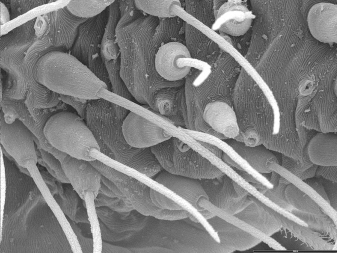
|
|
280. Cy > PLS spinning field (female): ventral-proper view (SEM)
When present! |
|
281. MS > PLS spinning field (female): ventral-proper view (SEM)
When present! |
|
283. PC > PLS spinning field (female): ventral-proper view (SEM)
When present! |
|
284. triad > PLS spinning field (female): ventral-proper view (SEM)
When present! |
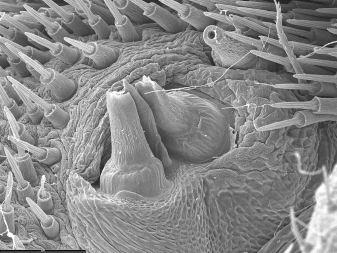
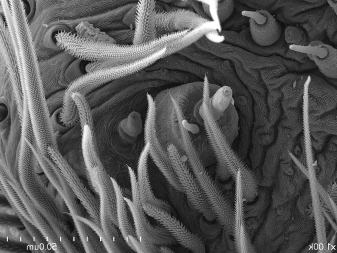
|
|
288. anal tubercle (female): posterior-proper view (SEM)
Tip: one apical image should be sufficient, add more if needed |
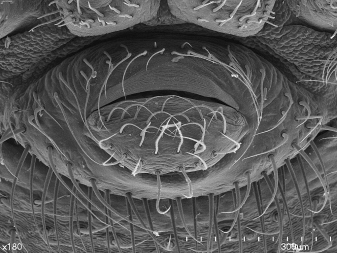
|
Preparation 10. Male in alcohol
|
34. habitus (male): dorsal view (photo)
Tip: no legs |
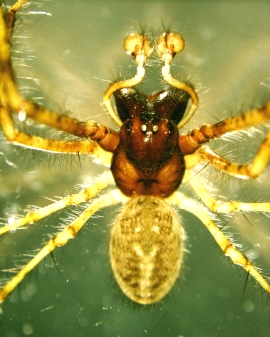
|
|
38. habitus (male): ventral view (photo)
Tip: no legs |
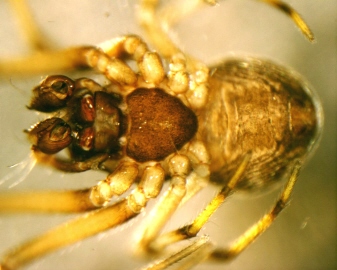
|
|
36. habitus (male): lateral view (photo)
Tip: no legs |
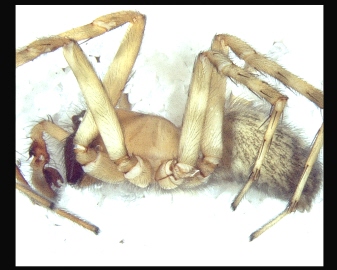
|
|
378. habitus with legs (male): lateral view (photo)
Tip: with legs |
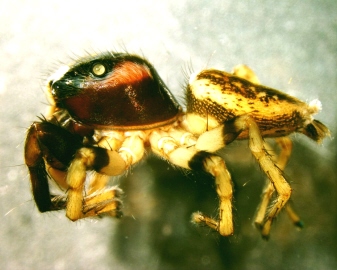
|
|
366. cephalothorax and base of appendages (male): ventral view (photo)
Tip: including coxae, trochanters, chelicera and pedicel |
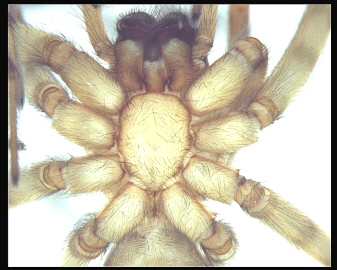
|
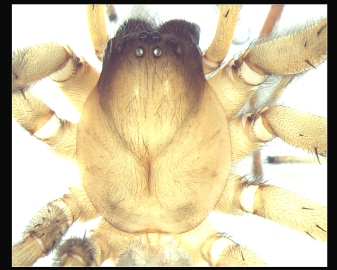
|
|
307. male palp and genitalia (male): ventral view, tarsus, bulb, tibia (photo)
Tip: this view can be replaced by a drawing (SV 306)
Zoom and check: degree of sclerotization of parts |

|
Preparation 11. Abdomen male
|
226. abdomen (male): anterior-dorsal view (SEM)
Zoom and check: illustrate sensilla, hairs and oddities around (especially on top of ) pedicel |
|
356. spiracle anterior booklung (male): ventral-proper view, left booklung (SEM)
Conditionally required: usually illustrated in SV 239 |
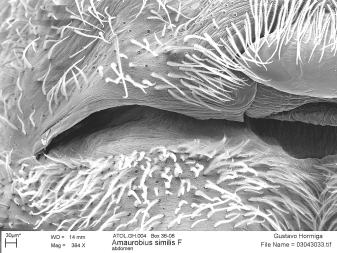
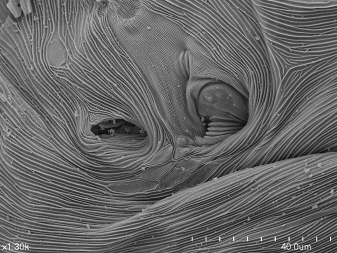
|
|
239. anterior booklung cover external surface (male): ventral-lateral view (SEM)
Tip: includes entire spiracle
Zoom and check: stridulatory surfaces; if spiracle not inlcuded, then add SV 356 |
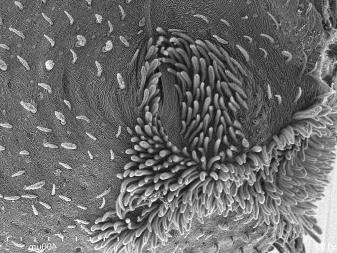
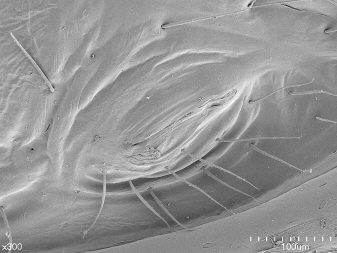
|
|
240. epiandrium (male): ventral-posterior view (SEM)
Zoom and check: if spigot origins not clear, add SV 18 |
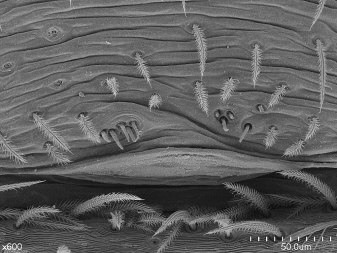
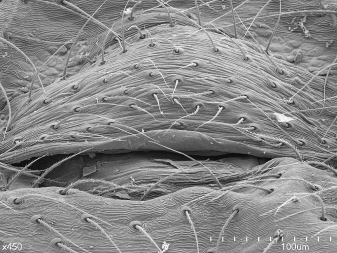
Document absence. |
|
18. epiandric spigots (male): ventral-posterior view (SEM)
When present! |
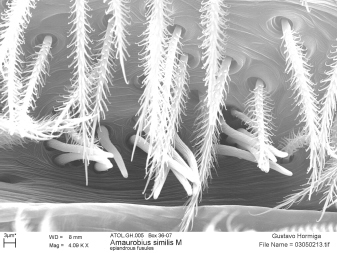
|
|
373. spiracles > 3rd abdominal segment (posterior booklungs or tracheae) (male): ventral view (SEM)
Conditionally required: may be illustrated together with spinnerets in SV 249; shave area if necessary, use also to document absence of spiracle |
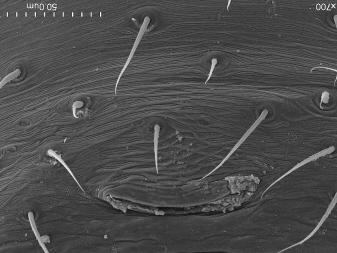
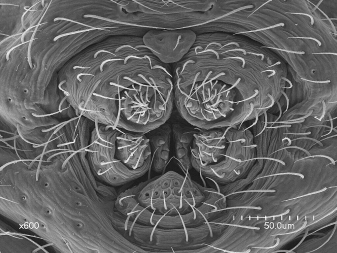
This view of the spinnerets may serve as well. |
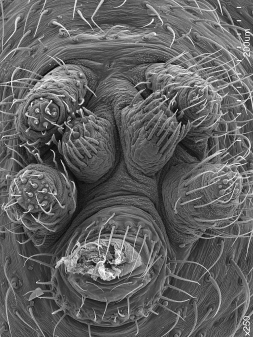
|
|
255. ALS spinning field (male): ventral-proper view (SEM)
When present! |
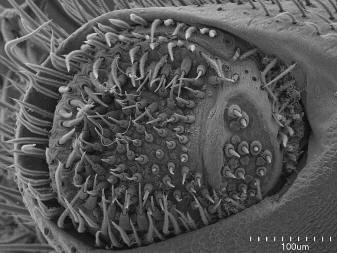
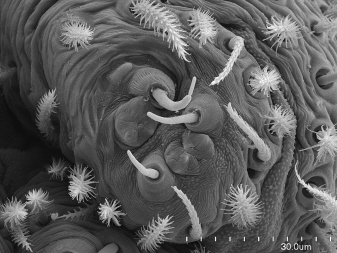
|
|
267. PMS spinning field (male): ventral-proper view (SEM)
Tip: entire spinning field or add extra images |
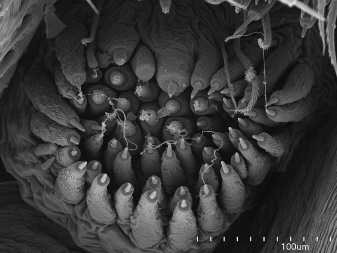
|
|
277. PLS spinning field (male): ventral-proper view (SEM)
When present! |
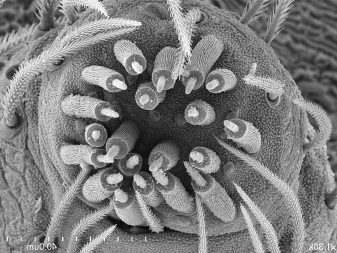
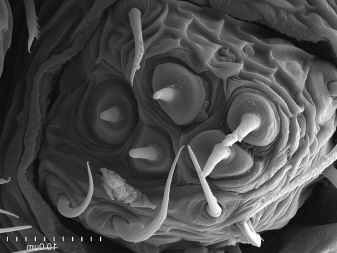
|
|
285. triad > PLS spinning field (male): ventral-proper view (SEM)
When present! |
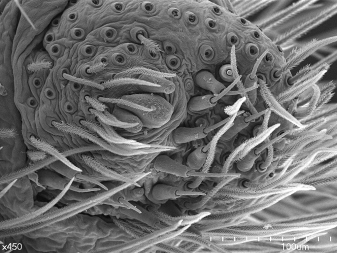
|
|
218. hairs abdomen (male): proper view, closeup one seta (SEM)
Tip: generic; default male, ventral; female ventral hairs from spinnerets mount is good as well |
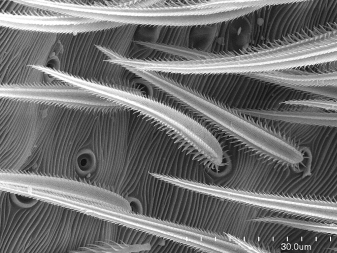
|
|
220. scales abdomen (male): proper view, closeup one seta (SEM)
Tip: generic; default male, ventral; female ventral hairs from spinnerets mount is good as well |
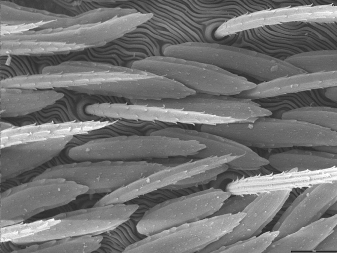
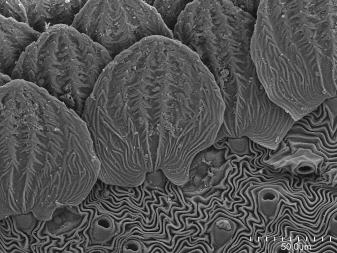
|
Preparation 12. Palp, SEM (male)
|
352. male palp and genitalia (male): dorsal view, tarsus, bulb, tibia (SEM)
Tip: priority orthogonal to cymbium/tarsus longitudinal axis
Zoom and check: if not orthogonal to tibia longitudinal axis, or if tibia details not resolved, add SV 321; if trichobothria not resolved, add SV 28 |
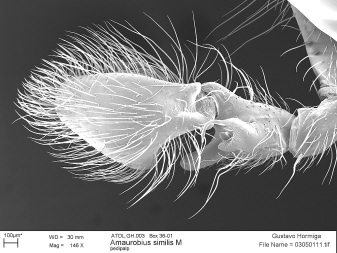
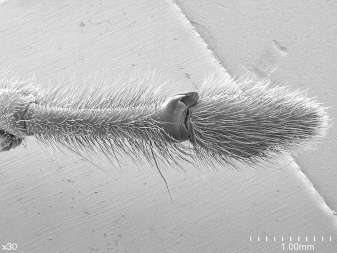
Include full length of tibiae. |
|
349. male palp and genitalia (male): ventral view, tarsus, bulb, tibia (SEM)
Tip: priority orthogonal to cymbium/tarsus longitudinal axis
Zoom and check: if tibia details not resolved, add SV 324
Additional structures you may found there: modifications and special setae on cymbial tip |
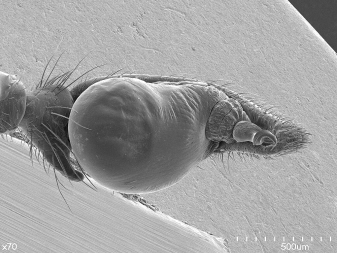
|
|
351. male palp and genitalia (male): prolateral view, tarsus, bulb, tibia (SEM)
Tip: can tilt slightly to get a better view |
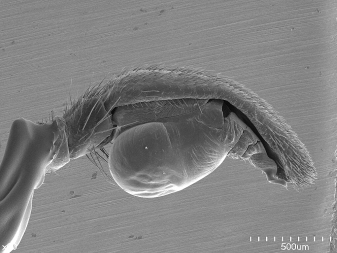
|
|
350. male palp and genitalia (male): retrolateral view, tarsus, bulb, tibia (SEM)
Tip: can tilt slightly to get a better view
Zoom and check: if tibia details not resolved, add SV 323
Additional structures you may found there: modifications and special setae on cymbial retromargin, paracymbium (SV 29, SV 27) |
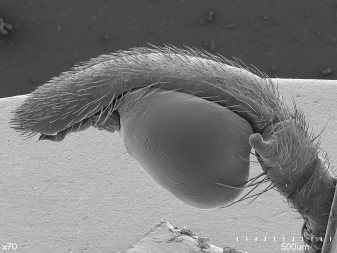
|
|
22. femoral thorns > femur > male palp and genitalia (male): prolateral view, closeup seta (SEM)
When present! |
|
321. tibia > male palp and genitalia (male): dorsal view (SEM)
Conditionally required: may be included in SV 352
Zoom and check: all processes
Additional structures you may found there: gland outlets, stridulatory areas |
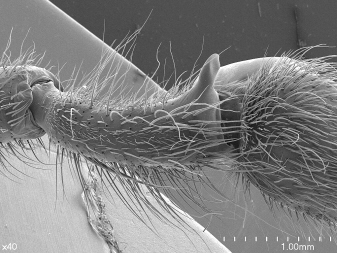
|
|
324. tibia > male palp and genitalia (male): ventral view (SEM)
Conditionally required: usually included in SV 359 |
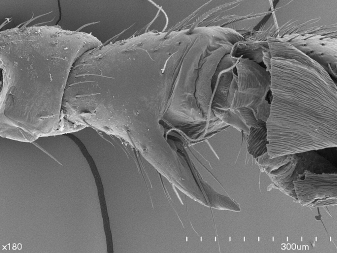
|
|
323. tibia > male palp and genitalia (male): retrolateral view (SEM)
Conditionally required: may be included in SV 350
Zoom and check: all processes
Additional structures you may found there: gland outlets, stridulatory areas |
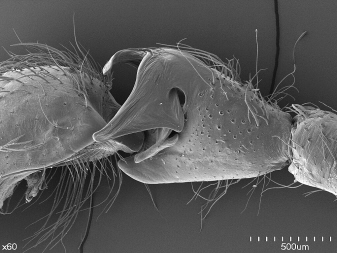
|
|
28. trichobothria > tarsus-cymbium > male palp and genitalia (male): dorsal-proper view (SEM)
When present! |
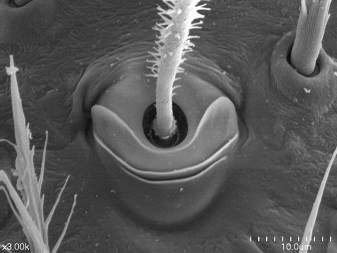
|
|
326. tarsus-cymbium > male palp and genitalia (male): dorsal view (SEM)
Conditionally required: usually included in SV 352 |
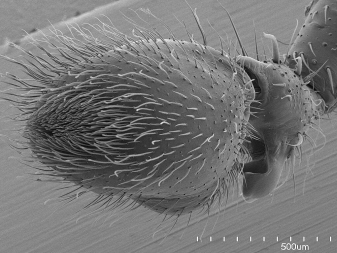
|
|
29. retrolateral paracymbial processes (male): retrolateral-proper view (SEM)
When present! |
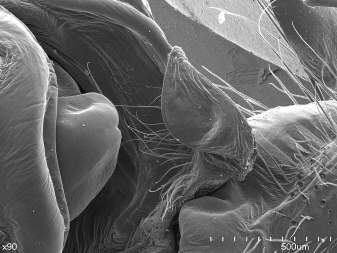
|
|
27. cymbial processes other than paracymbium > male palp and genitalia (male): proper view (SEM)
Conditionally required: usually included in general views |
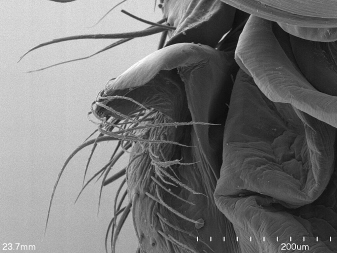
For example, the thomisid "tutaculum". |
|
368. copulatory bulb (male): ventral view (SEM)
Zoom and check: all sclerites illustrated in this and other views of the bulb |
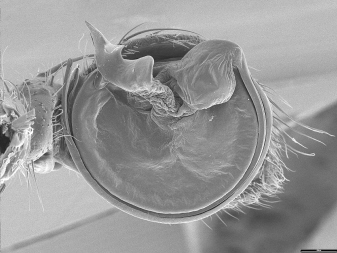
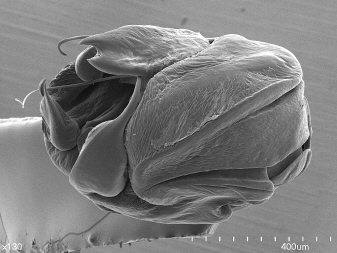
Sometimes the bulb is dissected and mounted apart. |
|
331. copulatory bulb (male): apical-proper view (SEM)
Tip: detail apical region, same preparation as SV 349 |
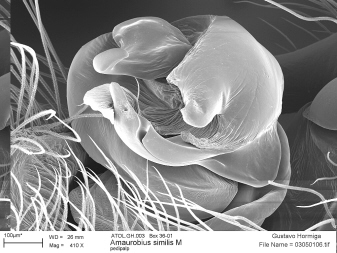
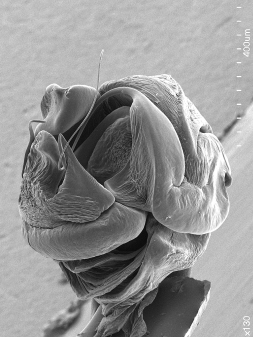
Sometimes the bulb is dissected and mounted apart. |
Preparation 13. Palp, expanded (male)
|
333. copulatory bulb (male): prolateral-proper view, expanded (photo)
Tip: only for expansible palps; can be replaced by an analytical drawing |
|
336. copulatory bulb (male): retrolateral-proper view, expanded (photo)
Tip: only for expansible palps; can be replaced by an analytical drawing |